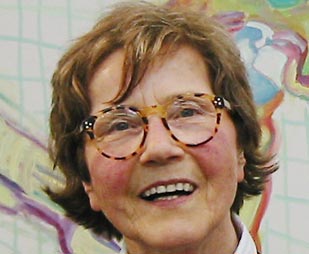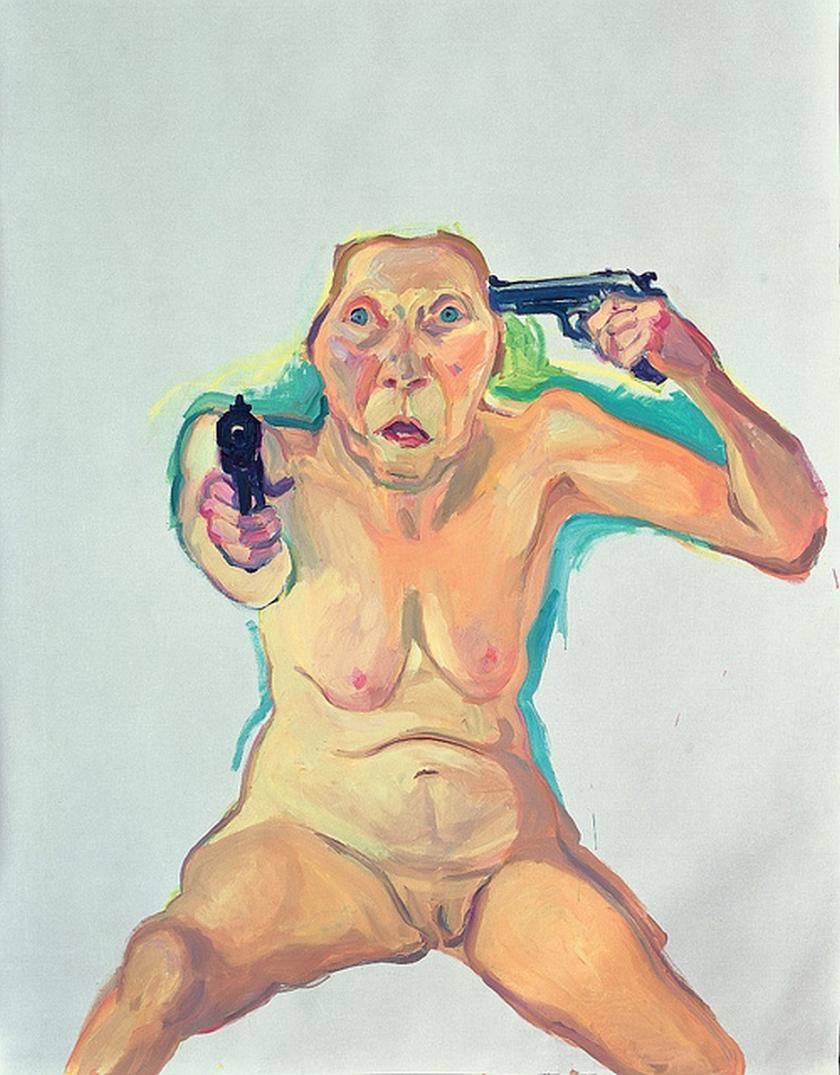Maria Lassnig, the Austrian figurative painter best known for her emotionally complex self-portraits, died yesterday aged 94. She was virtually unknown in the UK until her solo exhibition at the Serpentine Gallery in 2008. In a compact survey which focused on recent work one self-portrait - You or Me, 2005 (main picture) - attracted the greatest attention. Here the artist, aged 86, wears a startled expression while pointing a gun at her temple and one straight at the viewer. It is a promise of mutual destruction utterly alive with the presence of the artist.
Lassnig’s self-portraits, in which she usually appears naked, are disquieting, yet often not without humour. In them she appears confounded, desperate, alarmed. She is often preoccupied with capturing a moment in extremis, and yet her light, fluid, illustrative style is matter-of-fact, undercutting the angst, undermining any hint of hysteria. Practising what she called "body awareness" in her paintings, her figures usually appear against a white background – they arrive with no context, few identifying appurtenances. Stylistically there are echoes of Alice Neel and even David Hockney.
 Lassnig had been slowly and quietly gaining critical acclaim on the continent and in America for some time. She represented Austria, alongside feminist artist Valie Export, at the 1980 Venice Biennale, and she was the subject of a retrospective at the Centre Pompidou in 1996. Last year she received the Venice Biennale’s Golden Lion for lifetime achievement. An exhibition of her self-portraits can currently be seen at MoMA PS1, New York. It seems that, like a few other female artists, among them British painter Rose Wylie and the British sculptor of wreckage and detritus Phyllida Barlow, she is receiving her dues as a late bloomer. Like Barlow, Lassnig is represented in London by the blue-chip gallery Hauser and Wirth. (Lassnig pictured above; courtesy of Friedrich Petzel Gallery, New York)
Lassnig had been slowly and quietly gaining critical acclaim on the continent and in America for some time. She represented Austria, alongside feminist artist Valie Export, at the 1980 Venice Biennale, and she was the subject of a retrospective at the Centre Pompidou in 1996. Last year she received the Venice Biennale’s Golden Lion for lifetime achievement. An exhibition of her self-portraits can currently be seen at MoMA PS1, New York. It seems that, like a few other female artists, among them British painter Rose Wylie and the British sculptor of wreckage and detritus Phyllida Barlow, she is receiving her dues as a late bloomer. Like Barlow, Lassnig is represented in London by the blue-chip gallery Hauser and Wirth. (Lassnig pictured above; courtesy of Friedrich Petzel Gallery, New York)
And as with Wylie, at the time of Lassnig’s Serpentine exhibition one did sense a barely concealed, undeniably patronising media astonishment that a female artist could have produced such raw work at such an advanced age, as if psychologically probing portrayals of the non-idealised human figure have not been with us for some time. So it was when Wylie had her first solo exhibition at Jerwood Hastings, as if such huge paintings featuring stylised motifs from popular culture would not have formed the backdrop to Wylie’s own art education in her youth. Lassnig, like many artists, grew franker with the years, and this should not surprise us.









![SEX MONEY RACE RELIGION [2016] by Gilbert and George. Installation shot of Gilbert & George 21ST CENTURY PICTURES Hayward Gallery](/sites/default/files/styles/thumbnail_125_x_125_/public/mastimages/Gilbert%20%26%20George_%2021ST%20CENTURY%20PICTURES.%20SEX%20MONEY%20RACE%20RELIGION%20%5B2016%5D.%20Photo_%20Mark%20Blower.%20Courtesy%20of%20the%20Gilbert%20%26%20George%20and%20the%20Hayward%20Gallery._0.jpg?itok=3oW-Y84i)





Add comment